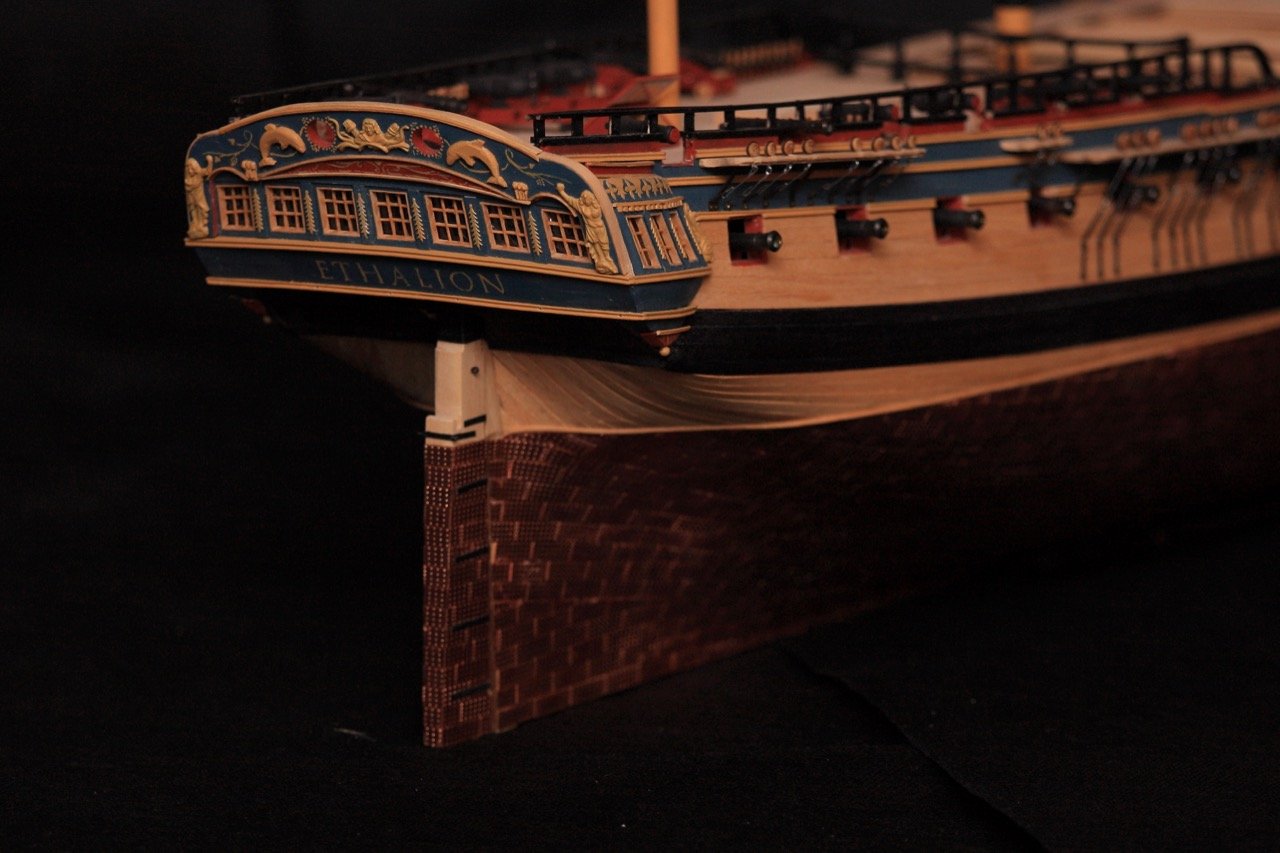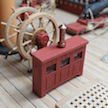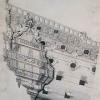-
Posts
831 -
Joined
-
Last visited
Reputation Activity
-
 robdurant reacted to Morten in Norway in Barque Stefano by robdurant - MarisStella - 1:63
robdurant reacted to Morten in Norway in Barque Stefano by robdurant - MarisStella - 1:63
Best wishes
-
 robdurant reacted to Baker in Mary Rose by Baker - scale 1/50 - "Your Noblest Shippe"
robdurant reacted to Baker in Mary Rose by Baker - scale 1/50 - "Your Noblest Shippe"
With all frames made thinner and the last planks attached to the stern, the rough shape of the hull and rear castle is largely finished.
A lot of wood chips.. And the first jar of PVA glue is empty
With paint pots visible in the background, time for some freshening up of the hobby room.
Current status with a cardboard fore castle
-
 robdurant reacted to Baker in Mary Rose by Baker - scale 1/50 - "Your Noblest Shippe"
robdurant reacted to Baker in Mary Rose by Baker - scale 1/50 - "Your Noblest Shippe"
This time an update without a misstep.. Everything went according to plan
The bulwark (frames) of the upper deck :
Logically speaking and thinking. This bulwark is constructed with partial planking and shields. In accordance with the waist, where there are also partly shields, why should all frames reach the top? If their only purpose is to hold up a beam with shields hanging from it?
Therefore, the height of the majority of frames is only up to the planking. And some go higher, the distance between these frames is approximately in accordance with that of the waist.
Saw the frames to height
And then narrow them to the 3mm
Then a beam is glued above the clinker planking. The connections are only to maintain sufficient strength on the model.
A new "frame" is placed And the longest frames are narrowed. and to 3mm.
The height is speculative, the shortest frame was the size.
Starboard is ready, just a small beam needs to be attached at the top. Some extra planking is done (arrow)
Thanks for following, likes and comments.
-
 robdurant got a reaction from Hubac's Historian in Mary Rose by Baker - scale 1/50 - "Your Noblest Shippe"
robdurant got a reaction from Hubac's Historian in Mary Rose by Baker - scale 1/50 - "Your Noblest Shippe"
Well done, good and faithful clamp. 😆It says something about the devotion you have to this wonderful build that when it's a choice between model or tool taking the hit, it's the tool... quite right, too 👏
Glad to hear both will make a good recovery. And thanks for sharing your thoughts, processes, steps (and even missteps) with us. I'm sure I'm not the only one learning a lot.
-
 robdurant got a reaction from Craigie65 in HM Gun Brig Adder by ECK - Vanguard Models - 1:64
robdurant got a reaction from Craigie65 in HM Gun Brig Adder by ECK - Vanguard Models - 1:64
Those are certainly some serious curves at the bow. Looks like a good solid base for the second planking. Thanks for sharing.
-
 robdurant got a reaction from DB789 in HM Gun Brig Adder by ECK - Vanguard Models - 1:64
robdurant got a reaction from DB789 in HM Gun Brig Adder by ECK - Vanguard Models - 1:64
Those are certainly some serious curves at the bow. Looks like a good solid base for the second planking. Thanks for sharing.
-
 robdurant got a reaction from ECK in HM Gun Brig Adder by ECK - Vanguard Models - 1:64
robdurant got a reaction from ECK in HM Gun Brig Adder by ECK - Vanguard Models - 1:64
Those are certainly some serious curves at the bow. Looks like a good solid base for the second planking. Thanks for sharing.
-
 robdurant got a reaction from AJohnson in HM Gun Brig Adder by ECK - Vanguard Models - 1:64
robdurant got a reaction from AJohnson in HM Gun Brig Adder by ECK - Vanguard Models - 1:64
Those are certainly some serious curves at the bow. Looks like a good solid base for the second planking. Thanks for sharing.
-
 robdurant reacted to ECK in HM Gun Brig Adder by ECK - Vanguard Models - 1:64
robdurant reacted to ECK in HM Gun Brig Adder by ECK - Vanguard Models - 1:64
OK, first planking done. Very deceptive due to the blunt bow and flat bottom. Harder to plank despite having done many many models. Fortunately, will try better with second planking and then of course filler and paint very forgiving. I do like the lines of the ship though.
-
 robdurant reacted to bigcreekdad in Erycina by robdurant - FINISHED - Vanguard Models - 1:64 - Plymouth Ketch-Rigged Trawler
robdurant reacted to bigcreekdad in Erycina by robdurant - FINISHED - Vanguard Models - 1:64 - Plymouth Ketch-Rigged Trawler
Got it....Thanks! Might try this myself.
-
 robdurant got a reaction from rcweir in Erycina by robdurant - FINISHED - Vanguard Models - 1:64 - Plymouth Ketch-Rigged Trawler
robdurant got a reaction from rcweir in Erycina by robdurant - FINISHED - Vanguard Models - 1:64 - Plymouth Ketch-Rigged Trawler
Hi. As I bring my latest update, let me see if I can explain my thinking better... but with the proviso that I may well be barking up the wrong tree, and if you see James H or Chris W doing something differently to me, there is almost certainly a good reason, and you're probably better of following their example
My reasoning in bringing the first strake down at the stern to meet the lower counter was to avoid having to butt join two planks together end to end - the planks provided in the kit aren't long enough to reach right to the end if they continue to rise with the pre-fitted piece that's already been fitted above the plank (and assuming that they're fitted as single pieces - not as halves, as per the first planking ... that isn't an issue where they're hidden underneath the fittings on the side of that hull that hold the rigging, but in my head I was worried the line would be visible, and look a little odd).
This way of doing it does leave a gap that needs a stealer for the last three inches or so... as in the photo below. I wasn't too worried about that, as I knew I'd need at least one stealer somewhere towards the stern. What it DOES mean, is that the stealer is then very much on show, which is perhaps less than desirable. It also means that the sweep of the planks now has to bend round the tuck under the counter - a somewhat more contorted route than simply following the row as Chris suggests, and as the photos in the manual show. Anyway - I was hoping it would look okay once the stealer was put in place, and here are the photos - you can judge for yourself... Hope that all makes sense
The first photo shows the first and second planks fitted on the port side, without the stealer in place. It looks messy, but the second plank neatly tucks in behind the first to make a neat transition at the corner of the counter...
The photo below shows the stealer fitted on the starboard side... It seems to me that this way of putting in the plank makes for a nice join between the planks as they meet at the counter... I haven't fitted the stealer on the port side yet, but I think I'm happy with how this is working out.
The final photo shows the first plank above the keel (the garboard strake?)... now these two at the top and one at the bottom are fitted, I'll measure the gap at intervals and start fitting every plank so I hopefully get a nice run for the remainder of the planking.
Thanks for following alone, and chipping in. And all the best with your build, @bigcreekdad! Are you thinking of starting a build log? We could learn from each other?
-
 robdurant reacted to chris watton in Chris Watton and Vanguard Models news and updates Volume 2
robdurant reacted to chris watton in Chris Watton and Vanguard Models news and updates Volume 2
I should get the final files for the figures next week, which I then need to set up on my 'slicing' program. I am thinking the more delicate parts may be better left on their base and supports, to help protect the more delicate parts, and the customer removes the supports. This isn't an issue, as I always use the lightest supports I can get away with to minimise the 'pock-marks' they leave behind.
I hope to have the full suite of 3-d printed ships boats before the year's out (so Sphinx and Indy will have an option for all 3-d printed hull boats) - this will be quite a large investment in money, but I think worth it, as even I prefer the 3-d printed hulls, so imagine quite a few customers may, too.
Regarding Harpy, I shall be sending Jim the laser cut, PE, 3-d printed parts next week, so you should see a build log of this soon. (I am very much looking forward to seeing what Jim does to this, I love the lines). I still have around 4-5 full working weeks for CAD (plan) work, so still plenty for me to do before even starting preliminaries for kit 18, which I anticipate starting in September.
Finaly, I have been told by my PE supplier that copper is back on the menu, but more expensive. So, I will eventually have the PE copper plate option back for kits that have copper bottoms. I will keep them a separate option, as I know some prefer not to copper the bottom, or some even prefer the tape, so do not want to increase the cost of a kit to take into account the expensive PE copper when not everyone will use it - Best to keep it an option.
-
 robdurant reacted to chris watton in Chris Watton and Vanguard Models news and updates Volume 2
robdurant reacted to chris watton in Chris Watton and Vanguard Models news and updates Volume 2
OK, dare I show them...Gulp...
Updated files
To me, they look great!
-
 robdurant reacted to chris watton in Chris Watton and Vanguard Models news and updates Volume 2
robdurant reacted to chris watton in Chris Watton and Vanguard Models news and updates Volume 2
The figure set is being reworked, so should have an update within the next few days.
In the meantime, I am busy producing Harpy fittings, laser cutting kits parts for orders and still working on Harpy CAD drawings in between everything else.
We have now become so busy that my wife will be working full time for Vanguard Models from September, as it is neither fair or untenable for her to have a full time day job, and then to come home and work again until late putting kits together. My accountant confirmed the validity of this today.
Our house is up for sale, as we need a larger premises, but no bites as yet, dammit....
-
 robdurant got a reaction from Knocklouder in Erycina by robdurant - FINISHED - Vanguard Models - 1:64 - Plymouth Ketch-Rigged Trawler
robdurant got a reaction from Knocklouder in Erycina by robdurant - FINISHED - Vanguard Models - 1:64 - Plymouth Ketch-Rigged Trawler
Hi. As I bring my latest update, let me see if I can explain my thinking better... but with the proviso that I may well be barking up the wrong tree, and if you see James H or Chris W doing something differently to me, there is almost certainly a good reason, and you're probably better of following their example
My reasoning in bringing the first strake down at the stern to meet the lower counter was to avoid having to butt join two planks together end to end - the planks provided in the kit aren't long enough to reach right to the end if they continue to rise with the pre-fitted piece that's already been fitted above the plank (and assuming that they're fitted as single pieces - not as halves, as per the first planking ... that isn't an issue where they're hidden underneath the fittings on the side of that hull that hold the rigging, but in my head I was worried the line would be visible, and look a little odd).
This way of doing it does leave a gap that needs a stealer for the last three inches or so... as in the photo below. I wasn't too worried about that, as I knew I'd need at least one stealer somewhere towards the stern. What it DOES mean, is that the stealer is then very much on show, which is perhaps less than desirable. It also means that the sweep of the planks now has to bend round the tuck under the counter - a somewhat more contorted route than simply following the row as Chris suggests, and as the photos in the manual show. Anyway - I was hoping it would look okay once the stealer was put in place, and here are the photos - you can judge for yourself... Hope that all makes sense
The first photo shows the first and second planks fitted on the port side, without the stealer in place. It looks messy, but the second plank neatly tucks in behind the first to make a neat transition at the corner of the counter...
The photo below shows the stealer fitted on the starboard side... It seems to me that this way of putting in the plank makes for a nice join between the planks as they meet at the counter... I haven't fitted the stealer on the port side yet, but I think I'm happy with how this is working out.
The final photo shows the first plank above the keel (the garboard strake?)... now these two at the top and one at the bottom are fitted, I'll measure the gap at intervals and start fitting every plank so I hopefully get a nice run for the remainder of the planking.
Thanks for following alone, and chipping in. And all the best with your build, @bigcreekdad! Are you thinking of starting a build log? We could learn from each other?
-
 robdurant got a reaction from chris watton in Erycina by robdurant - FINISHED - Vanguard Models - 1:64 - Plymouth Ketch-Rigged Trawler
robdurant got a reaction from chris watton in Erycina by robdurant - FINISHED - Vanguard Models - 1:64 - Plymouth Ketch-Rigged Trawler
Hi. As I bring my latest update, let me see if I can explain my thinking better... but with the proviso that I may well be barking up the wrong tree, and if you see James H or Chris W doing something differently to me, there is almost certainly a good reason, and you're probably better of following their example
My reasoning in bringing the first strake down at the stern to meet the lower counter was to avoid having to butt join two planks together end to end - the planks provided in the kit aren't long enough to reach right to the end if they continue to rise with the pre-fitted piece that's already been fitted above the plank (and assuming that they're fitted as single pieces - not as halves, as per the first planking ... that isn't an issue where they're hidden underneath the fittings on the side of that hull that hold the rigging, but in my head I was worried the line would be visible, and look a little odd).
This way of doing it does leave a gap that needs a stealer for the last three inches or so... as in the photo below. I wasn't too worried about that, as I knew I'd need at least one stealer somewhere towards the stern. What it DOES mean, is that the stealer is then very much on show, which is perhaps less than desirable. It also means that the sweep of the planks now has to bend round the tuck under the counter - a somewhat more contorted route than simply following the row as Chris suggests, and as the photos in the manual show. Anyway - I was hoping it would look okay once the stealer was put in place, and here are the photos - you can judge for yourself... Hope that all makes sense
The first photo shows the first and second planks fitted on the port side, without the stealer in place. It looks messy, but the second plank neatly tucks in behind the first to make a neat transition at the corner of the counter...
The photo below shows the stealer fitted on the starboard side... It seems to me that this way of putting in the plank makes for a nice join between the planks as they meet at the counter... I haven't fitted the stealer on the port side yet, but I think I'm happy with how this is working out.
The final photo shows the first plank above the keel (the garboard strake?)... now these two at the top and one at the bottom are fitted, I'll measure the gap at intervals and start fitting every plank so I hopefully get a nice run for the remainder of the planking.
Thanks for following alone, and chipping in. And all the best with your build, @bigcreekdad! Are you thinking of starting a build log? We could learn from each other?
-
 robdurant got a reaction from AJohnson in Erycina by robdurant - FINISHED - Vanguard Models - 1:64 - Plymouth Ketch-Rigged Trawler
robdurant got a reaction from AJohnson in Erycina by robdurant - FINISHED - Vanguard Models - 1:64 - Plymouth Ketch-Rigged Trawler
Hi. As I bring my latest update, let me see if I can explain my thinking better... but with the proviso that I may well be barking up the wrong tree, and if you see James H or Chris W doing something differently to me, there is almost certainly a good reason, and you're probably better of following their example
My reasoning in bringing the first strake down at the stern to meet the lower counter was to avoid having to butt join two planks together end to end - the planks provided in the kit aren't long enough to reach right to the end if they continue to rise with the pre-fitted piece that's already been fitted above the plank (and assuming that they're fitted as single pieces - not as halves, as per the first planking ... that isn't an issue where they're hidden underneath the fittings on the side of that hull that hold the rigging, but in my head I was worried the line would be visible, and look a little odd).
This way of doing it does leave a gap that needs a stealer for the last three inches or so... as in the photo below. I wasn't too worried about that, as I knew I'd need at least one stealer somewhere towards the stern. What it DOES mean, is that the stealer is then very much on show, which is perhaps less than desirable. It also means that the sweep of the planks now has to bend round the tuck under the counter - a somewhat more contorted route than simply following the row as Chris suggests, and as the photos in the manual show. Anyway - I was hoping it would look okay once the stealer was put in place, and here are the photos - you can judge for yourself... Hope that all makes sense
The first photo shows the first and second planks fitted on the port side, without the stealer in place. It looks messy, but the second plank neatly tucks in behind the first to make a neat transition at the corner of the counter...
The photo below shows the stealer fitted on the starboard side... It seems to me that this way of putting in the plank makes for a nice join between the planks as they meet at the counter... I haven't fitted the stealer on the port side yet, but I think I'm happy with how this is working out.
The final photo shows the first plank above the keel (the garboard strake?)... now these two at the top and one at the bottom are fitted, I'll measure the gap at intervals and start fitting every plank so I hopefully get a nice run for the remainder of the planking.
Thanks for following alone, and chipping in. And all the best with your build, @bigcreekdad! Are you thinking of starting a build log? We could learn from each other?
-
 robdurant got a reaction from dunnock in Erycina by robdurant - FINISHED - Vanguard Models - 1:64 - Plymouth Ketch-Rigged Trawler
robdurant got a reaction from dunnock in Erycina by robdurant - FINISHED - Vanguard Models - 1:64 - Plymouth Ketch-Rigged Trawler
I've managed to get started on the second planking for Erycina... Here are a few shots.
Before I began, I went through the planks with a digital micrometer to sort them into thickness... That way, I don't get any nasty surprises with thin planks going up against thick planks... I can grade it as I plank. There wasn't anything too dramatic, but it's nice to go into the task with a plan. The planks varied from 0.6 to 1mm thick, and some varied up to 0.2mm from end to end... As I said, nothing too dramatic, and it'll even out with scraping once done. There are a couple of strips that are perhaps a little too thin, but counting up, I should have enough without using these strips. They will be backups, then.
For this planking, I use gorilla glue thick superglue - used carefully, this does a great job and removes the need for pins and clamps... The theory is that it gives a better end result... I'm realising that I'm out of practice, so we'll find out whether this model ends up getting painted, or whether the wood will look okay once done. I try to put little dots of glue along the (pre-fitted) plank before fitting to the hull... So far, I'm putting on too much glue, and it's made things a little messy. Anyway - here's the progress so far. Upper parts fitted, and the first row of planking on each side.
One decision I made was to let the plank stay at the bottom end of the counter at the stern, so that there will be a filler between it and the upper outer part... this was because if it were to follow the line of the upper part (102, 103?), it would have been too short, and I wanted to avoid joins. I figure it'll look fine once I put the filler in as long as I get a good fit, but I would have preferred to keep the sweep of the planks, ideally. A different option would be to join the planks where the chain plates will be... I made my choice, and I think I'm happy with it. Time will tell how easy that tuck under the stern is... thankfully I have the rib bender, so this next plank down will need to be well fitted before I attempt to get it to stay in place with glue! PPPPPP, as they say ... (Proper Preparation Prevents "Profoundly" Poor Performance)
As always, the pear strips are a simply beautiful colour, and there are no visible machining marks on them whatsoever. It's simply lovely wood to work with!
Thanks for looking in.
Rob
-
 robdurant got a reaction from mtaylor in Mary Rose by Baker - scale 1/50 - "Your Noblest Shippe"
robdurant got a reaction from mtaylor in Mary Rose by Baker - scale 1/50 - "Your Noblest Shippe"
Well done, good and faithful clamp. 😆It says something about the devotion you have to this wonderful build that when it's a choice between model or tool taking the hit, it's the tool... quite right, too 👏
Glad to hear both will make a good recovery. And thanks for sharing your thoughts, processes, steps (and even missteps) with us. I'm sure I'm not the only one learning a lot.
-
 robdurant got a reaction from AJohnson in Erycina by robdurant - FINISHED - Vanguard Models - 1:64 - Plymouth Ketch-Rigged Trawler
robdurant got a reaction from AJohnson in Erycina by robdurant - FINISHED - Vanguard Models - 1:64 - Plymouth Ketch-Rigged Trawler
I've managed to get started on the second planking for Erycina... Here are a few shots.
Before I began, I went through the planks with a digital micrometer to sort them into thickness... That way, I don't get any nasty surprises with thin planks going up against thick planks... I can grade it as I plank. There wasn't anything too dramatic, but it's nice to go into the task with a plan. The planks varied from 0.6 to 1mm thick, and some varied up to 0.2mm from end to end... As I said, nothing too dramatic, and it'll even out with scraping once done. There are a couple of strips that are perhaps a little too thin, but counting up, I should have enough without using these strips. They will be backups, then.
For this planking, I use gorilla glue thick superglue - used carefully, this does a great job and removes the need for pins and clamps... The theory is that it gives a better end result... I'm realising that I'm out of practice, so we'll find out whether this model ends up getting painted, or whether the wood will look okay once done. I try to put little dots of glue along the (pre-fitted) plank before fitting to the hull... So far, I'm putting on too much glue, and it's made things a little messy. Anyway - here's the progress so far. Upper parts fitted, and the first row of planking on each side.
One decision I made was to let the plank stay at the bottom end of the counter at the stern, so that there will be a filler between it and the upper outer part... this was because if it were to follow the line of the upper part (102, 103?), it would have been too short, and I wanted to avoid joins. I figure it'll look fine once I put the filler in as long as I get a good fit, but I would have preferred to keep the sweep of the planks, ideally. A different option would be to join the planks where the chain plates will be... I made my choice, and I think I'm happy with it. Time will tell how easy that tuck under the stern is... thankfully I have the rib bender, so this next plank down will need to be well fitted before I attempt to get it to stay in place with glue! PPPPPP, as they say ... (Proper Preparation Prevents "Profoundly" Poor Performance)
As always, the pear strips are a simply beautiful colour, and there are no visible machining marks on them whatsoever. It's simply lovely wood to work with!
Thanks for looking in.
Rob
-
 robdurant got a reaction from AJohnson in Erycina by robdurant - FINISHED - Vanguard Models - 1:64 - Plymouth Ketch-Rigged Trawler
robdurant got a reaction from AJohnson in Erycina by robdurant - FINISHED - Vanguard Models - 1:64 - Plymouth Ketch-Rigged Trawler
Counter added. As noted in the manual, this didn't require any soaking - it just fitted nicely. You'll notice below that I managed to break the top of the inner transom part... the grain runs vertically here, so it's almost impossible to avoid... I've tucked away these parts, and I'll refit them when I add the outer part on. In the meantime, it allowed me better access to clamp the counter.
Today, the final sides have been added to the keel. This is a clever way of effectively creating a rabbet ready for the second planking...
Thanks for looking in
Rob
-
 robdurant got a reaction from Craigie65 in Erycina by robdurant - FINISHED - Vanguard Models - 1:64 - Plymouth Ketch-Rigged Trawler
robdurant got a reaction from Craigie65 in Erycina by robdurant - FINISHED - Vanguard Models - 1:64 - Plymouth Ketch-Rigged Trawler
I've managed to get started on the second planking for Erycina... Here are a few shots.
Before I began, I went through the planks with a digital micrometer to sort them into thickness... That way, I don't get any nasty surprises with thin planks going up against thick planks... I can grade it as I plank. There wasn't anything too dramatic, but it's nice to go into the task with a plan. The planks varied from 0.6 to 1mm thick, and some varied up to 0.2mm from end to end... As I said, nothing too dramatic, and it'll even out with scraping once done. There are a couple of strips that are perhaps a little too thin, but counting up, I should have enough without using these strips. They will be backups, then.
For this planking, I use gorilla glue thick superglue - used carefully, this does a great job and removes the need for pins and clamps... The theory is that it gives a better end result... I'm realising that I'm out of practice, so we'll find out whether this model ends up getting painted, or whether the wood will look okay once done. I try to put little dots of glue along the (pre-fitted) plank before fitting to the hull... So far, I'm putting on too much glue, and it's made things a little messy. Anyway - here's the progress so far. Upper parts fitted, and the first row of planking on each side.
One decision I made was to let the plank stay at the bottom end of the counter at the stern, so that there will be a filler between it and the upper outer part... this was because if it were to follow the line of the upper part (102, 103?), it would have been too short, and I wanted to avoid joins. I figure it'll look fine once I put the filler in as long as I get a good fit, but I would have preferred to keep the sweep of the planks, ideally. A different option would be to join the planks where the chain plates will be... I made my choice, and I think I'm happy with it. Time will tell how easy that tuck under the stern is... thankfully I have the rib bender, so this next plank down will need to be well fitted before I attempt to get it to stay in place with glue! PPPPPP, as they say ... (Proper Preparation Prevents "Profoundly" Poor Performance)
As always, the pear strips are a simply beautiful colour, and there are no visible machining marks on them whatsoever. It's simply lovely wood to work with!
Thanks for looking in.
Rob
-
 robdurant got a reaction from JacquesCousteau in Erycina by robdurant - FINISHED - Vanguard Models - 1:64 - Plymouth Ketch-Rigged Trawler
robdurant got a reaction from JacquesCousteau in Erycina by robdurant - FINISHED - Vanguard Models - 1:64 - Plymouth Ketch-Rigged Trawler
I've managed to get started on the second planking for Erycina... Here are a few shots.
Before I began, I went through the planks with a digital micrometer to sort them into thickness... That way, I don't get any nasty surprises with thin planks going up against thick planks... I can grade it as I plank. There wasn't anything too dramatic, but it's nice to go into the task with a plan. The planks varied from 0.6 to 1mm thick, and some varied up to 0.2mm from end to end... As I said, nothing too dramatic, and it'll even out with scraping once done. There are a couple of strips that are perhaps a little too thin, but counting up, I should have enough without using these strips. They will be backups, then.
For this planking, I use gorilla glue thick superglue - used carefully, this does a great job and removes the need for pins and clamps... The theory is that it gives a better end result... I'm realising that I'm out of practice, so we'll find out whether this model ends up getting painted, or whether the wood will look okay once done. I try to put little dots of glue along the (pre-fitted) plank before fitting to the hull... So far, I'm putting on too much glue, and it's made things a little messy. Anyway - here's the progress so far. Upper parts fitted, and the first row of planking on each side.
One decision I made was to let the plank stay at the bottom end of the counter at the stern, so that there will be a filler between it and the upper outer part... this was because if it were to follow the line of the upper part (102, 103?), it would have been too short, and I wanted to avoid joins. I figure it'll look fine once I put the filler in as long as I get a good fit, but I would have preferred to keep the sweep of the planks, ideally. A different option would be to join the planks where the chain plates will be... I made my choice, and I think I'm happy with it. Time will tell how easy that tuck under the stern is... thankfully I have the rib bender, so this next plank down will need to be well fitted before I attempt to get it to stay in place with glue! PPPPPP, as they say ... (Proper Preparation Prevents "Profoundly" Poor Performance)
As always, the pear strips are a simply beautiful colour, and there are no visible machining marks on them whatsoever. It's simply lovely wood to work with!
Thanks for looking in.
Rob
-
 robdurant got a reaction from rcweir in Erycina by robdurant - FINISHED - Vanguard Models - 1:64 - Plymouth Ketch-Rigged Trawler
robdurant got a reaction from rcweir in Erycina by robdurant - FINISHED - Vanguard Models - 1:64 - Plymouth Ketch-Rigged Trawler
I've managed to get started on the second planking for Erycina... Here are a few shots.
Before I began, I went through the planks with a digital micrometer to sort them into thickness... That way, I don't get any nasty surprises with thin planks going up against thick planks... I can grade it as I plank. There wasn't anything too dramatic, but it's nice to go into the task with a plan. The planks varied from 0.6 to 1mm thick, and some varied up to 0.2mm from end to end... As I said, nothing too dramatic, and it'll even out with scraping once done. There are a couple of strips that are perhaps a little too thin, but counting up, I should have enough without using these strips. They will be backups, then.
For this planking, I use gorilla glue thick superglue - used carefully, this does a great job and removes the need for pins and clamps... The theory is that it gives a better end result... I'm realising that I'm out of practice, so we'll find out whether this model ends up getting painted, or whether the wood will look okay once done. I try to put little dots of glue along the (pre-fitted) plank before fitting to the hull... So far, I'm putting on too much glue, and it's made things a little messy. Anyway - here's the progress so far. Upper parts fitted, and the first row of planking on each side.
One decision I made was to let the plank stay at the bottom end of the counter at the stern, so that there will be a filler between it and the upper outer part... this was because if it were to follow the line of the upper part (102, 103?), it would have been too short, and I wanted to avoid joins. I figure it'll look fine once I put the filler in as long as I get a good fit, but I would have preferred to keep the sweep of the planks, ideally. A different option would be to join the planks where the chain plates will be... I made my choice, and I think I'm happy with it. Time will tell how easy that tuck under the stern is... thankfully I have the rib bender, so this next plank down will need to be well fitted before I attempt to get it to stay in place with glue! PPPPPP, as they say ... (Proper Preparation Prevents "Profoundly" Poor Performance)
As always, the pear strips are a simply beautiful colour, and there are no visible machining marks on them whatsoever. It's simply lovely wood to work with!
Thanks for looking in.
Rob
-
 robdurant got a reaction from ccoyle in Erycina by robdurant - FINISHED - Vanguard Models - 1:64 - Plymouth Ketch-Rigged Trawler
robdurant got a reaction from ccoyle in Erycina by robdurant - FINISHED - Vanguard Models - 1:64 - Plymouth Ketch-Rigged Trawler
I've managed to get started on the second planking for Erycina... Here are a few shots.
Before I began, I went through the planks with a digital micrometer to sort them into thickness... That way, I don't get any nasty surprises with thin planks going up against thick planks... I can grade it as I plank. There wasn't anything too dramatic, but it's nice to go into the task with a plan. The planks varied from 0.6 to 1mm thick, and some varied up to 0.2mm from end to end... As I said, nothing too dramatic, and it'll even out with scraping once done. There are a couple of strips that are perhaps a little too thin, but counting up, I should have enough without using these strips. They will be backups, then.
For this planking, I use gorilla glue thick superglue - used carefully, this does a great job and removes the need for pins and clamps... The theory is that it gives a better end result... I'm realising that I'm out of practice, so we'll find out whether this model ends up getting painted, or whether the wood will look okay once done. I try to put little dots of glue along the (pre-fitted) plank before fitting to the hull... So far, I'm putting on too much glue, and it's made things a little messy. Anyway - here's the progress so far. Upper parts fitted, and the first row of planking on each side.
One decision I made was to let the plank stay at the bottom end of the counter at the stern, so that there will be a filler between it and the upper outer part... this was because if it were to follow the line of the upper part (102, 103?), it would have been too short, and I wanted to avoid joins. I figure it'll look fine once I put the filler in as long as I get a good fit, but I would have preferred to keep the sweep of the planks, ideally. A different option would be to join the planks where the chain plates will be... I made my choice, and I think I'm happy with it. Time will tell how easy that tuck under the stern is... thankfully I have the rib bender, so this next plank down will need to be well fitted before I attempt to get it to stay in place with glue! PPPPPP, as they say ... (Proper Preparation Prevents "Profoundly" Poor Performance)
As always, the pear strips are a simply beautiful colour, and there are no visible machining marks on them whatsoever. It's simply lovely wood to work with!
Thanks for looking in.
Rob












